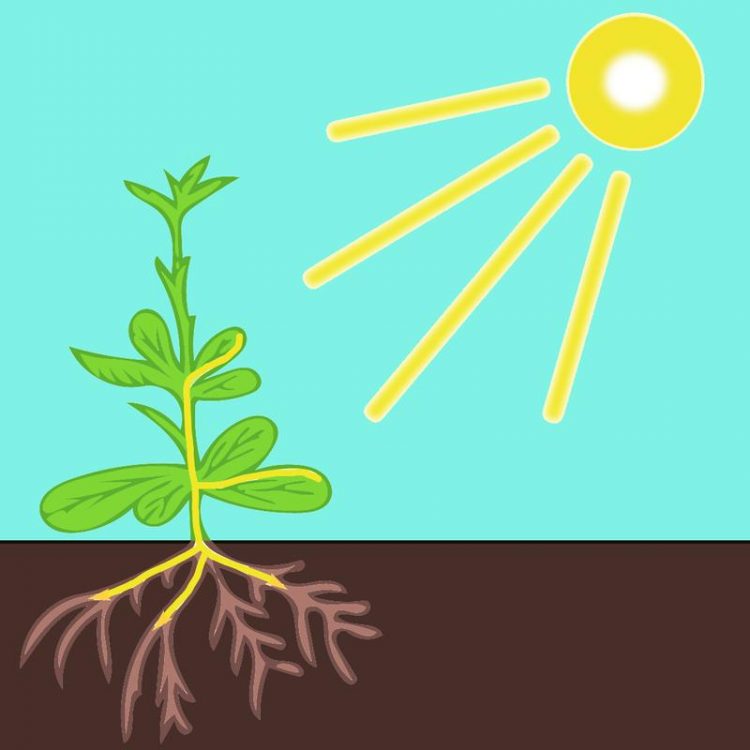Plant roots in the dark see light

Photoreceptors in the roots are activated by light which is transmitted from the shoot to the underground roots through the stem. Rakesh Santhanam, Angela Overmeyer / Max Planck Institute for Chemical Ecology
Light is not only a source of energy, but also an important signal which regulates many light-dependent growth processes in a plant in order to adapt it to its environment in the best possible way. Light is first detected by photoreceptors in the shoot of a plant. Physiological processes in the plant are mediated by light signaling molecules. For more than three decades, scientists have been speculating whether roots are also able to perceive light.
However, this hypothesis could never be proved until this new study was published. “Physicists from Korea and biologists from Jena teamed and combined knowledge from both disciplines in order to find out, whether plant vascular bundles could act as light optical fibers and transmit light from the shoot to the roots,” Sang-Gyu Kim, one of the first authors of the study and co-initiator of the project, describes the successful cooperation.
Previous studies had shown that a special photoreceptor in plants which detects light of the wavelength red/far-red is surprisingly also expressed in the roots. However, it remained unclear how this root photoreceptor was activated. In an interdisciplinary effort, molecular biologists and optical physicists developed a highly sensitive optical detector along with the idea to compare plants with “blind” and “sighted” roots. They used plants of the thale cress Arabidopsis thaliana, a model organism in plant research, which were genetically modified in a way that the photoreceptor was only silenced in their roots, but not in their shoots. Hence, these plants had “blind” roots.
The scientists grew these modified plants along with control plants; their roots were in the dark soil and their shoots exposed to light, just like in nature. The optical detector system was used to measure light which was transmitted in the stem down to the roots. “With this approach, we could show clearly and without ambiguity that light is transmitted into the roots via vascular bundles. Even if the intensity of the transmitted light was low, it was sufficient to activate the photoreceptors, trigger downstream light signaling, and influence growth in the control plants,” Chung-Mo Park, the leader of the project at Seoul National University, explains.
“These results are crucial for further research projects. Our work proves that roots are able to perceive light, even though they are usually found belowground. Photoreception in the roots triggers a signaling chain which influences plant growth, especially the root architecture,” says Ian Baldwin, leader of the study at the Max Planck Institute for Chemical Ecology in Jena. He already looks into the future: “There are more photoreceptors in the roots. Until now, it has remained largely unknown what their responsibilities in the roots are and how they interact with light signals which are transmitted from the shoots.”
It is of major importance for ecological research to show the relevance of this study for plants growing in their natural habitat. To find out, the scientists want to perform experiments with another plant species, the coyote tobacco Nicotiana attenuata, a model plant in ecology, which is adapted to an extremely strong exposition to light. The researchers propose that the newly found sensory modality of roots is enhancing the ecological performance of plants in nature, by allowing for a better timing of resource allocations for growth, reproduction and defense. [KG/AO]
Original Publication:
Lee, H.-J., Ha, J.-H., Kim, S.-G., Choi, H.-K., Kim, Z. H., Han, Y.-J., Kim, J.-I., Oh, Y., Fragoso, V., Shin, K., Hyeon, T., Choi, H.-G., Oh, K.-H., Baldwin, I. T., Park, C.-M. (2016). Stem-piped light activates phytochrome B to trigger light responses in Arabidopsis thaliana roots. Science Signaling. Vol. 9, Issue 452, pp. ra106
http://dx.doi.org/10.1126/scisignal.aaf6530
Further Information:
Prof. Ian T. Baldwin, Max Planck Institute for Chemical Ecology, Hans-Knöll-Str. 8, 07743 Jena, Germany, +49 3641 57-1101, E-Mail baldwin@ice.mpg.de
Prof. Chung-Mo Park, Department of Chemistry, Seoul National University, Seoul, Korea 08826, +82 2 880-6640, E-Mail cmpark@snu.ac.kr
Contact and Media Requests:
Angela Overmeyer M.A., Max Planck Institute for Chemical Ecology, Hans-Knöll-Str. 8, 07743 Jena, +49 3641 57-2110, E-Mail overmeyer@ice.mpg.de
Download high-resolution images via http://www.ice.mpg.de/ext/downloads2016.html
http://www.ice.mpg.de/ext/index.php?id=molecular-ecology Department of Molecular Ecology
Media Contact
All latest news from the category: Life Sciences and Chemistry
Articles and reports from the Life Sciences and chemistry area deal with applied and basic research into modern biology, chemistry and human medicine.
Valuable information can be found on a range of life sciences fields including bacteriology, biochemistry, bionics, bioinformatics, biophysics, biotechnology, genetics, geobotany, human biology, marine biology, microbiology, molecular biology, cellular biology, zoology, bioinorganic chemistry, microchemistry and environmental chemistry.
Newest articles

A ‘language’ for ML models to predict nanopore properties
A large number of 2D materials like graphene can have nanopores – small holes formed by missing atoms through which foreign substances can pass. The properties of these nanopores dictate many…

Clinically validated, wearable ultrasound patch
… for continuous blood pressure monitoring. A team of researchers at the University of California San Diego has developed a new and improved wearable ultrasound patch for continuous and noninvasive…

A new puzzle piece for string theory research
Dr. Ksenia Fedosova from the Cluster of Excellence Mathematics Münster, along with an international research team, has proven a conjecture in string theory that physicists had proposed regarding certain equations….



